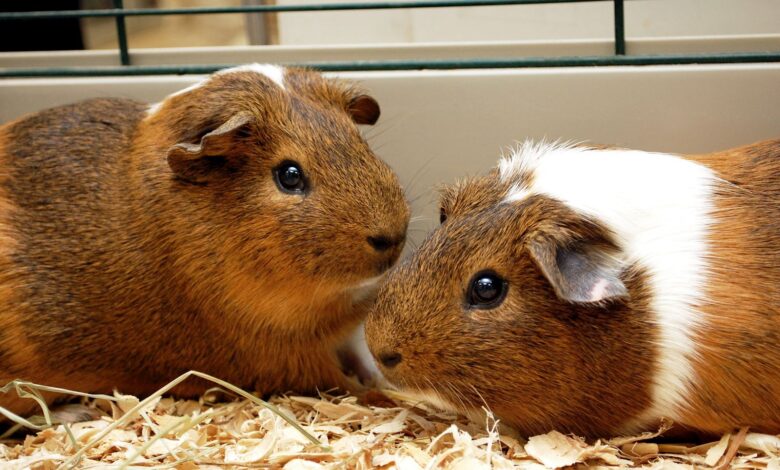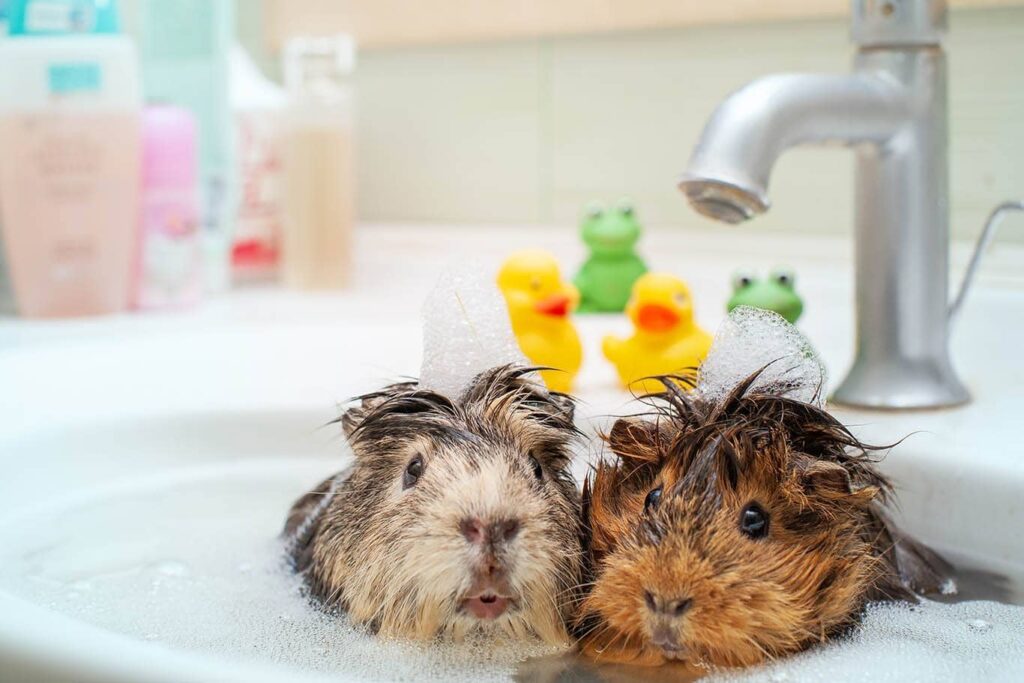All About Guinea Pigs

If you don’t have a lot of spare time or space in your apartment, but want to adopt a pet, then a guinea pig might be a great option for you. Guinea pigs don’t require a tremendous amount of time, or space, and are relatively easy to take care of.
Home guinea pigs aren’t aggressive and all and get attached to people rather quickly. Around 27% of animal lovers chose guinea pigs as their home pets. They hold fifth place in being the most popular pets, after dogs, cats, hamsters, and parrots.
But where do they get their name, “pig” especially? These funny animals came to Europe from South America. The first specimens were brought by the Spaniards in the XVI century. These animals were called “pigs” perhaps because they make funny grunts when they sleep and squeal in delight.
There are many different breeds of guinea pigs. Pet stores usually have the most common ones (short-haired and long-haired), but also some rare breeds: Baldwin or “naked”, teddy or “plush”, ridgeback, etc.
Be sure to inspect the animal you’ve just bought. The coat of a healthy guinea pig should be glossy, without bald spots. The eyes should be clean, with no mucus coming from the nose.
You should buy a guinea pig after it reaches the age of 3-4 weeks. At that age, a baby guinea pig doesn’t need a mother’s milk, and it will be easier for your new pet to get used to your presence and the new environment.
First, you should arrange a suitable dwelling for your new guinea pig. Guinea pigs don’t tolerate heat and draft well. The optimal temperature for them is considered to be 18-20 °C. They are easily scared, so make sure to keep them away from any loud noises.
Where should you keep a guinea pig?

Choosing a cage for this is the most popular and practical option. The cage should be spacious, with an average dimension of 90 × 60 × 40 cm. Choose the ones with plastic pallets instead of lattice bottoms if you don’t want your pet to get stuck between the bars constantly.
Don’t choose multi-leveled cages either; even if your guinea pig manages to climb up, it’ll be difficult for it to get down without help, and falling even from a small distance may cause a lot of injuries. The main disadvantage of settling a guinea pig in a cage is that dust and excrement may fall out of it.
A glass terrarium is much more hygienic in this respect. Sawdust won’t fall out of it, leaving the area around the terrarium more clean. However, this creates a problem of poor ventilation, and the litter inside will be wet most of the time.

Another alternative is a miniature enclosure. Its height shouldn’t be less than 40 cm, otherwise, your guinea pig might escape. You can create an improved version of an enclosure by choosing a container with a hinged lattice lid. But pick a spacious model, otherwise, your guinea pig will be depressed.
Apart from providing a dwelling, you should ensure your guinea pig has a suitable litter to imitate soft grass and earth. The most popular option is sawdust. But you can also use fleece fabric or polyvinyl chloride mat.
Remember to place a feeder and a drinking bowl in the cage. Ideally, they should be suspended, since sawdust, dust, and excrement can get into them if they are on the ground. Don’t forget to feed your guinea pig daily and refresh the water. Hay is the main product of a guinea pig’s diet, so it’s a good idea to invest in a special hay box, but don’t simply throw food onto the ground.
Remember that your pet also needs privacy. Install a house in its cage where your pet can rest and hide from prying eyes and relax in silence. Guinea pigs love to lie on something soft – make sure to provide a suitable bed place for them or hang a hammock.
Guinea pigs are rather shy. They will be feeling uncertain once you’ve relocated them to a new place. Don’t take them in your arms in order to calm down – this way you’ll only add to their fear. Give your pet some time to get accustomed to your smell, its new home, and surroundings in general.
Offer your guinea pig a treat – a piece of carrot or some hay – and wait for it to come up and take it. Repeat this every day until you’re sure your pet trusts you. Only after that, you can pick it up. Gently stroke its head and back, saying affectionate words.

Don’t make sudden movements and show your pet that it’s not in danger. Guinea pigs usually get along well with children, but you should be cautious when passing your pet to a child. The child should be old enough to understand that animals should be treated carefully.
Some rules guinea pig owners need to know:
- if you want to take a guinea pig into your hand, grab it under its front paw with one and support it backside with the other;
- guinea pigs are very timid, so don’t grab them suddenly;
- keep noise to a minimum and don’t knock on its cage – guinea pigs love privacy, peace, and quiet;
- use treats to get your pet accustomed to sitting in your hands;
- talk to them – guinea pigs can get bored if they live alone, and they don’t live in solitude;
- let your guinea pig frolic and run around the house outside the cage at least once a day.
Nutrition and diet

Guinea pigs are rather low-maintenance animals. Their main food is hay and dry food. A Guinea pig will be happy to eat wheat, oats, and barley. To keep your pet healthy, you should provide a balanced diet. You can buy special food for guinea pigs in pet stores.
You can safely include clover, chamomile, dandelion, alfalfa, and other garden and meadow grasses into the diet. Carrots, cucumbers, beetroot, pumpkin, zucchini, celery, and cabbage are great for guinea pigs too. Apples, bananas, pears, strawberries, and pitted cherries are the best options out of fruits and berries.
Carefully study the list of products guinea pigs can’t eat. Such as dairy products, meat and fish, pasta, potatoes, mushrooms, eggs, legumes, onions, garlic, bread, and any sweets. Giving it to a guinea pig can destroy its digestive system and lead to chronic diseases and possibly death.
Don’t overfeed your guinea pigs, especially if it doesn’t get enough exercise. The daily portion should not exceed 20-30% of the guinea pig’s weight. The product must be fresh and of high quality. Try to diversify your pet’s diet, and choose different options from time to time.
Guinea pig care

Guinea pigs are extremely clean animals, which is a big plus for future owners. They don’t smell bad if you don’t forget to clean the cage in time.
You shouldn’t wash your pet often, but if you need to, there are several points to consider. You can wash a guinea pig in a plastic basin filled with warm water around 38-40 °C. The water level should be around 3-5 cm.
Use baby shampoo or a special shampoo for small rodents. You’re your pet carefully, make sure that water doesn’t get into its ears, nose, or eyes. After washing, dry it thoroughly with a towel.
If you own a long-haired guinea pig, don’t forget to comb its fur every day so it doesn’t tangle. Clean the ears of your pet regularly to prevent it from going deaf. Be patient with your guinea pig, especially if you’re washing it for the first time. It might be stressful for them, and they can bite.
If you provide the best care for your pet guinea pig, then you’ll get a loyal and cute companion, giving you all the positive emotions for a long time.
Read more on: https://recommend24.com/category/pet-supplies/



